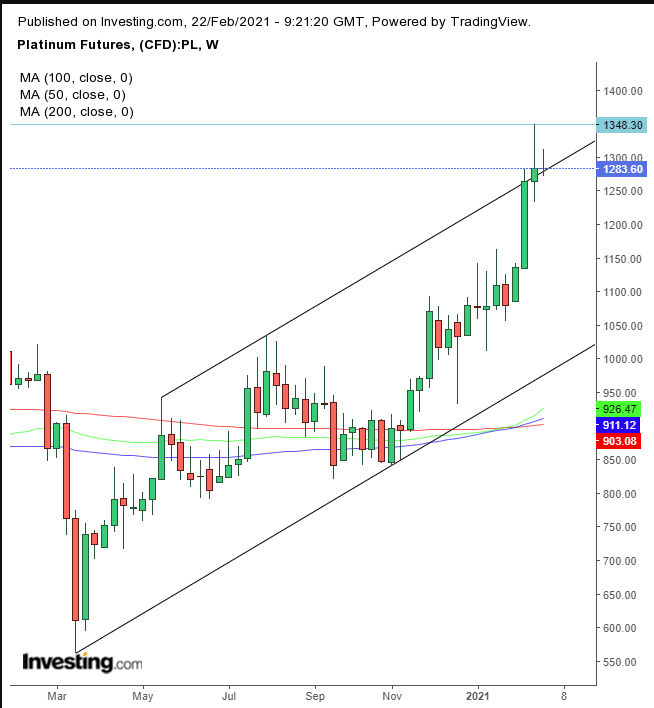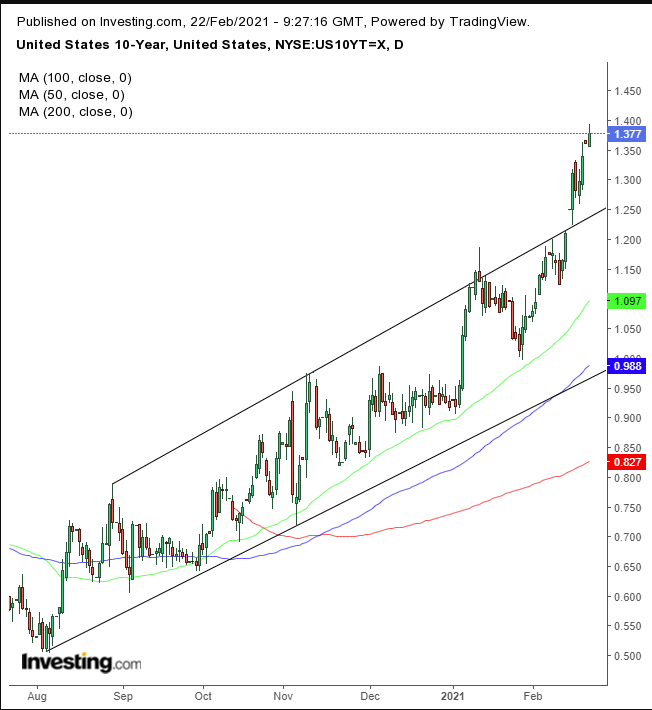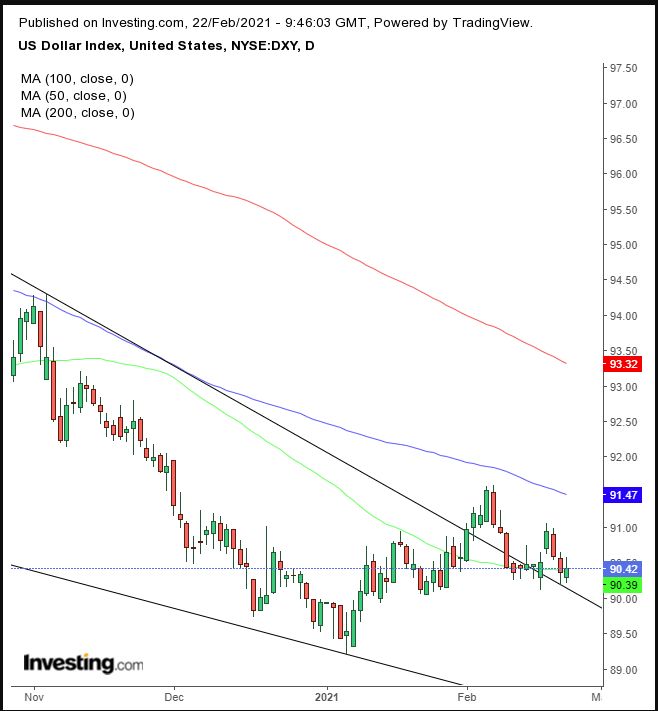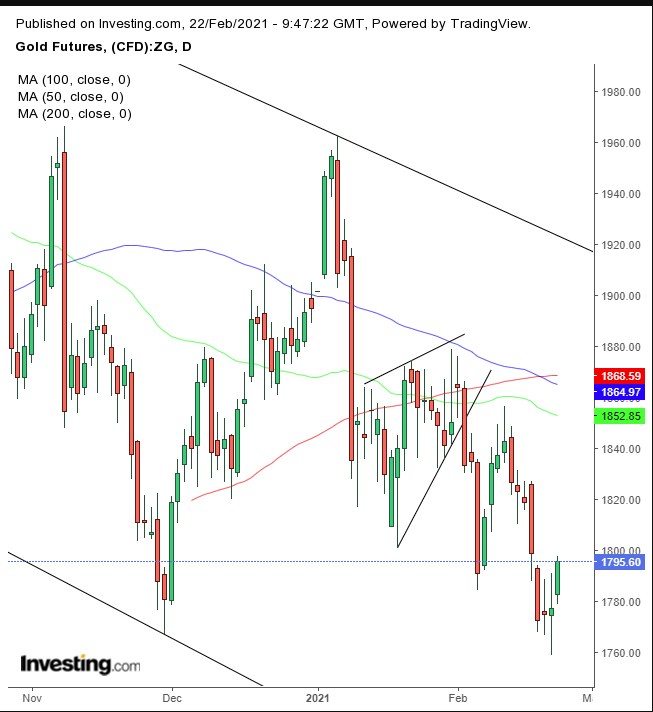- Gold, platinum, copper and yields rise
- Commodity demand boosts the dollar
- Equites are trading in the red
Key Events
Fears that rising inflation will upend the economic recovery dampened the markets' bullish spirits even as coronavirus vaccines seem to be helping reduce the spread of the virus. Futures contracts on the Dow, S&P, NASDAQ and Russell 2000 were all lower on Monday as the trading week kicked off.
Bitcoin slumped while oil rebounded.
Global Financial Affairs
Metals have been surging following rising Treasury yields, driven by inflation concerns. Platinum was trading near its 6-year high, as institutions have been redirecting the flow of capital to precious metals as a cheaper store of value after gold’s rise last year.

The price of platinum is struggling for the second week at the top of its rising channel, as inflation concerns push the precious metal into a steeper incline, whereas reflation hopes return it to retest the bottom of its current rising channel. Meanwhile, the weekly moving averages entered bullish formation, with each major MA higher than its longer counterparts.
Also, copper has rallied, surging as much as 4% today. The base metal is on track for its eleventh monthly advance in February, for the first time in history. Demand has skyrocketed on the expectations of an economic recovery, which is ironic, as it is the opposite to the reason given for the increased demand for platinum.
Still, we have often seen and reported contradictory market narratives. For example, the current inflation concerns versus the reflation trade. Reflation is considered positive for economic recovery, as rising prices are seen as part and parcel of rising output after an economic dip. Rising prices are also considered a benefit to everyone in the economy, as rising company profits lead to expansion and job creation. However, the current market narrative dictates that inflation is a headwind to the same economic recovery the reflation trade is banking on.
Investors have been selling off Treasuries, including the 10-year note, as their current yields are now considered low. Instead they have been buying metals or holding onto their cash in order to purchase new bond issues with a higher yield.

The benchmark yield has broken through its rising channel, increasing the odds for a higher incline.
The spread between the 5- and 30-year yields—a measure used to predict rising inflation—touched the highest level in over five years.
Yields were also rising in other countries, including the UK, Australia and Spain, raising fears that central banks may be forced to tighten policies to keep inflation in check.
The MSCI All-Country World Index—tracking 49 countries—fell 0.4% at the European open.
All four major US futures were well into negative territory on Monday morning with contracts on the NASDAQ 100 falling the most. Though declining tech has been manifesting the outlook for a reopening economy, futures on the Russell 2000 were close behind, suggesting broad profit taking from either side of the cyclical rotation.
Still, from a technical perspective, NASDAQ 100 futures weren’t looking good.

They completed a H&S top on the four-hour chart.
In Europe, the STOXX 600 was also led lower on Monday led by technology shares. The pan-European benchmark was down 1% at a ten day low.
In Asia, China led declines, as the PBoC left rates unchanged. It is somewhat surprising that this was the stated reason for the underperformance, given keeping the one-year loan prime rate at 3.85% was the consensus.

The dollar found support above the falling wedge since the March peak, after a second upside breakout.
The same inflation concerns boosted gold as an inflation-hedge.

But the outlook for the yellow metal is still bearish after the rising flag that achieved only half its implied target amid a falling channel and after a death cross.
Bitcoin fell, wiping out two days of gains. The cryptocurrency is trading at the bottom of the session.
Oil rebounded from a two-day selloff, but the commodity failed to hold on to an attempted advance back above $60.

Oil traders will be closely watching the crude oil inventories report after the production stop in Texas last week due to storms and freezing weather.
Up Ahead
- Federal Reserve Chairman Jerome Powell delivers the central bank’s semi-annual monetary policy report to the Senate Banking Committee on Tuesday.
- Lowe’s (NYSE:LOW) and Home Depot (NYSE:HD) are reporting earnings on Tuesday and Wednesday respectively.
- EIA crude oil inventory report is out on Wednesday.
- Finance ministers and central bankers from the G-20, including US Treasury Secretary, Janet Yellen will meet virtually on Friday.
Market Moves
Stocks
- Futures on the S&P 500 Index declined 0.7%.
- The FTSE 100 Index declined 0.7%
- The STOXX 600 Index declined 0.9%.
- The MSCI Asia Pacific Index declined 0.8%.
- The MSCI Emerging Markets Index declined 1.4%.
Currencies
- The Dollar Index advanced less than 0.15 to 90.42
- The British pound dipped 0.1% to $1.4007.
- The euro declined 0.1% to $1.2103.
- The Japanese yen weakened 0.3% to 105.81 per dollar.
Bonds
- Britain’s 10-year yield advanced two basis points to 0.717%.
- The yield on 10-year Treasuries jumped four basis points to 1.37%.
- The yield on two-year Treasuries increased less than one basis point to 0.11%.
- Germany’s 10-year yield gained one basis point to -0.30%.
Commodities
- West Texas Intermediate crude gained 0.7%.
- Gold strengthened 0.6% to $1,795.22 an ounce.
